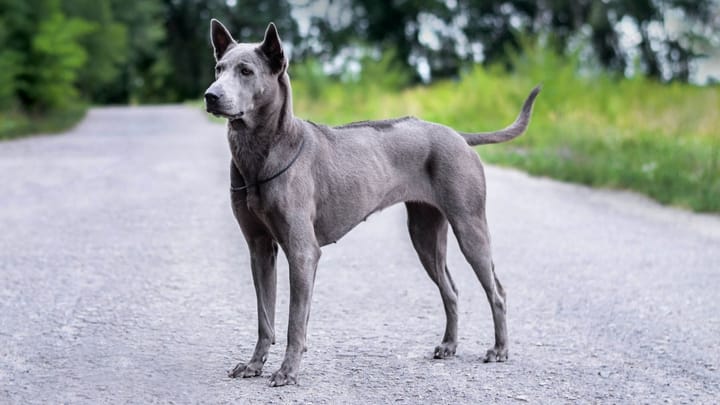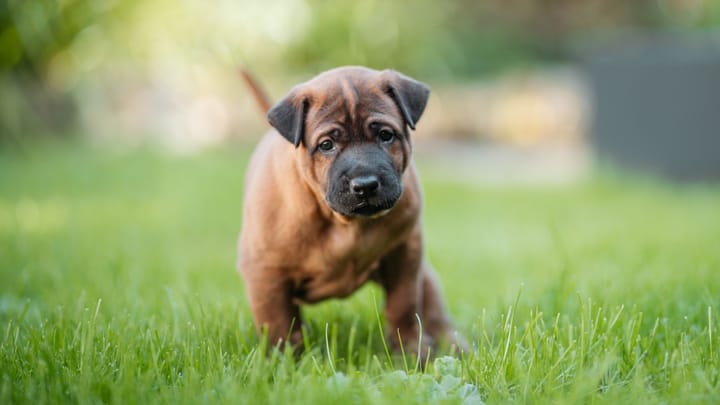Thai Ridgeback Dog
Other names : Thai Ridgeback, TRD, Thai Dog, Mah Thai, Lung Arn


This stunning, tough, alert and energetic dog originates from Thailand over 4,000 years ago but has since gained popularity in the Western world. The Thai Ridgeback is fiercely devoted and protective of its family, and so, must be well-socialised and trained to prevent aggressive behaviour towards strangers.
With that said, this breed is loyal, affectionate and loving towards the people it knows and trusts. It makes a wonderfully playful and energetic pet when handled in the right way. Be warned, though - this is a smart, independent breed which can be a little unpredictable. The Thai Ridgeback also has an extremely strong prey-drive and normally can’t be kept around cats or small animals.
|
Life expectancy |
The Thai Ridgeback Dog has a life expectancy of between 11 and 13 years |
|
Temperament |
|
|
Size |
Medium
|
|
Adult size |
Female
Between 20 and 22 in
Male
Between 22 and 24 in
|
|
Adult weight |
Female
Between 44 and 55 lb
Male
Between 55 and 66 lb
|
|
Coat colour
The coat is normally black, blue, brindle, brown, red or white. Some dogs have a black mask if they’re another colour all over. |
Black Blue Red Sand |
|
Type of coat
The Thai Ridgeback’s coat is very short. This breed has a short, hard, fine coat with a distinct, beautiful ridge of hair which runs right along the back - hence their name! |
Short |
|
Eye colour
The eyes are mostly brown but are sometimes amber. |
Brown
|
|
Purchase price |
The Thai Ridgeback Dog costs approximately 1500£ |
The defining feature of this beautiful dog has to be the wolf-like ridge of hair running along the back. It grows in the opposite direction to the rest of the coat and has been identified in eight different patterns - feather, arrow, needle, lute, violin, bowling pin, saddleback and leaf.
More details about the Thai Ridgeback Dog
Thai Ridgeback Dog: Origins and history
The Thai Ridgeback is the national dog of Thailand and is believed to have originated there over 4,000 years ago. It’s considered a ‘primitive dog’ due to its wolf-like characteristics. The breed is thought to originally have thrived in Eastern Thailand. However, the exact origins of the breed are unknown and still debated to this day.
Physical characteristics of the Thai Ridgeback Dog
This breed is certainly impressive, with a strong, tough, yet elegant appearance. This is a medium-sized breed with a muscular, sturdy, squarish body with long, lean legs. Their skin is visibly loose, especially around the back of the neck. Females are always significantly smaller than males.
They have a distinct ‘wedge’-like head and wrinkled forehead skin. The ears are wide-set, alert and slightly forward, the eyes are expressive and almond-shaped and the nose is black. Often, Thai Ridgebacks have spotted tongues.
FCI classification of the Thai Ridgeback Dog
-
Group 5 - Spitz and primitive types
-
Section 7 : Primitive type - Hunting Dogs
Thai Ridgeback Dog: Characteristics
Thai Ridgeback Dog: Behaviour
Training a Thai Ridgeback Dog
Looking for an easy-to-train, obedient, calm dog? The Thai Ridgeback isn’t the one! Despite their intelligence and ability to learn fast, this breed is stubborn and therefore, difficult to train. They will (yes, it’s a definite!) test boundaries and behave badly if allowed to get away with it.
We can’t stress enough that intensive training and socialization of the Thai Ridgeback is essential. Without it, they really could be a nightmare pet, through no fault of their own. Therefore, it’s essential that only experienced dog handlers adopt this breed.
Thai Ridgeback Dog: Lifestyle
Breed compatibility Thai Ridgeback Dog
Thai Ridgeback Dog: Purchase price
A Thai Ridgeback puppy is rather expensive - you’re looking at £1500 or more.
Concerning your monthly budget, on average, this dog would cost you between £30 to £40.
Thai Ridgeback Dog: Shedding
Average
The Thai Ridgeback doesn’t shed much and may be a good choice for those sensitive to dander. A weekly brush will help to minimize the shedding even further.
Thai Ridgeback Dog: Grooming
One of the best things about the Thai Ridgeback is their low-maintenance grooming. Their short, hard and straight coasts need no more than a weekly brush and a wipe down when they get a little mucky. They’ll also need an occasional bath. A few times a year maximum is best, as overly-regular bathing can dry out and irritate their skin.
This breed’s nails grow rapidly and should be checked and trimmed regularly. As with any other dog breed, make sure to check the eyes and ears, check for signs of infection and clean them if necessary. You should also brush their teeth as much as possible - at least once a week, but ideally daily.
Thai Ridgeback Dog: Health
The Thai Ridgeback lives, on average, for around 11 - 13 years.
This breed is extremely strong, agile and athletic - a real tough cookie. They’re known to hunt cobras in Asia - so if that’s not strong, we don’t what is!
However, this breed is not adapted to very low temperatures.
Originating from a tropical country, the Thai Ridgeback copes incredibly well in warm weather and loves soaking up the sun. That’s not to say they don’t need access to shade and water, though - they’ll still get hot in burning sunshine.
It’s best to keep a Thai Ridgeback indoors when the weather turns chilly - they won’t enjoy the cold weather and do not have adequate protection for the cold in terms of their coat.
The Thai Ridgeback is an active, agile breed and isn’t prone to gaining weight. However, in a domesticated setting with minimal exercise, they may pile on the pounds - especially if they’ve been spayed or neutered. Make sure you’re taking your dog on regular walks and continue weighing out food portions throughout their life to prevent overfeeding.
- Hip dysplasia
- Dermoid Sinus Cyst





